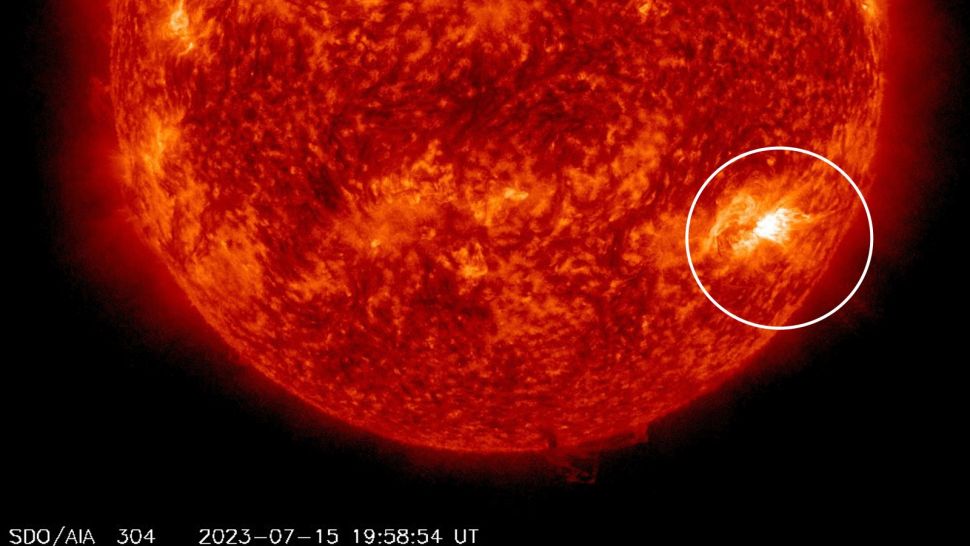'Cannibal' coronal mass ejection that devoured 'dark eruption' from sun will smash into Earth on July 18
Two coronal mass ejections have combined into an enormous cloud of magnetized plasma that is forecast to hit Earth on Tuesday and potentially trigger a strong geomagnetic storm.

A "cannibal" coronal mass ejection birthed from multiple solar storms, including a surprise "dark eruption," is currently on a collision course with Earth and could trigger a sizable geomagnetic storm on our planet when it hits on Tuesday (July 18).
Coronal mass ejections (CMEs) are large, fast-moving clouds of magnetized plasma and solar radiation that occasionally get flung into space alongside solar flares — powerful explosions on the sun's surface that are triggered when horseshoe-shaped loops of plasma located near sunspots snap in half like an overstretched elastic band. If CMEs smash into Earth, they can cause geomagnetic storms — disturbances in our planet's magnetic field — that can trigger partial radio blackouts and produce vibrant aurora displays much farther away from Earth's magnetic poles than normal.
A cannibal CME is created when an initial CME is followed by a second faster one. When the second CME catches up to the first cloud, it engulfs it, creating a single, massive wave of plasma.
Related: Solar activity may peak 1 year earlier than thought. Here is what it means
On July 14, the sun launched a CME alongside a dark eruption — a solar flare containing unusually cool plasma that makes it look like a dark wave compared to the rest of the sun's fiery surface — from sunspot AR3370, a small dark patch that until then had gone largely unnoticed, according to Spaceweather.com. On July 15, a second, faster CME was launched from the much larger sunspot AR3363.
A simulation from the National Oceanic and Atmospheric Administration (NOAA) Space Weather Prediction Center showed that the second storm will catch up with the first CME and form a cannibalistic cloud, with a strong likelihood of it hitting Earth on July 18.
Both CMEs came from C-class solar flares, the mid-tier of solar eruption strength. On their own, they would be too weak to trigger significant geomagnetic storms. But their combined size and speed mean they are likely to trigger a G1 or G2 level disturbance, the two highest classes for a geomagnetic storm.
Breaking space news, the latest updates on rocket launches, skywatching events and more!
Cannibal CMEs are rare because they require successive CMEs that are perfectly aligned and traveling at specific speeds. But there have been several in the last few years.
In November 2021, a cannibal CME smashed into Earth, triggering one of the first major geomagnetic storms of the current solar cycle. Two more CMEs slammed into our planet in 2022, the first in March and another in August, but both only triggered minor G3-class storms.
Cannibal CMEs become more likely during the solar maximum, the chaotic peak of the sun's roughly 11-year solar cycle. During this time, the number of sunspots and solar flares increases sharply as the sun's magnetic field becomes increasingly unstable.
Scientists initially predicted that the next solar maximum would arrive in 2025 and be weak compared to past solar cycles. But Live Science recently reported that the sun's explosive peak could arrive sooner — and be more powerful — than previously expected. Weird solar phenomena, such as cannibal CMEs, further indicates the solar maximum is fast approaching.
Earth has already been hit by five G1 or G2 geomagnetic storms this year, including the most powerful storm for more than six years. These storms have superheated the thermosphere — the second-highest layer of Earth's atmosphere — to its highest temperature in more than 20 years.
The number of sunspots is also increasing as we approach solar maximum, reaching its highest total for almost 21 years in June.

Harry is a U.K.-based staff writer at Live Science. He studied Marine Biology at the University of Exeter (Penryn campus) and after graduating started his own blog site "Marine Madness," which he continues to run with other ocean enthusiasts. He is also interested in evolution, climate change, robots, space exploration, environmental conservation and anything that's been fossilized. When not at work he can be found watching sci-fi films, playing old Pokemon games or running (probably slower than he'd like).


